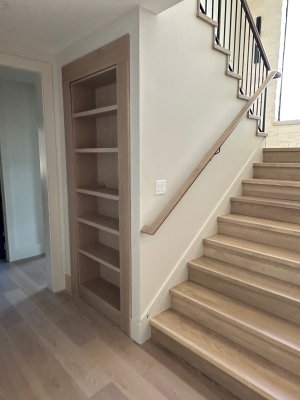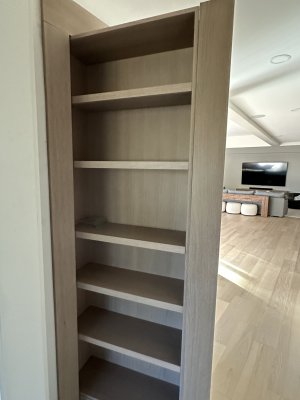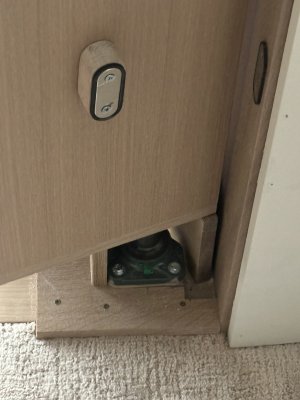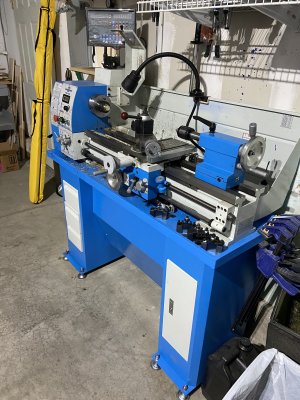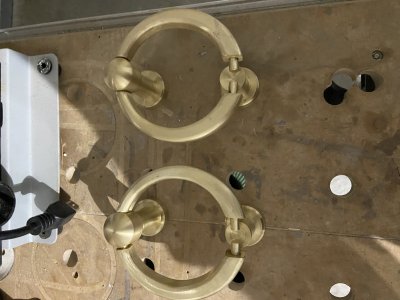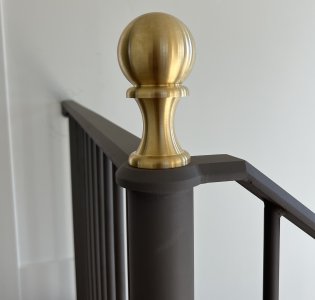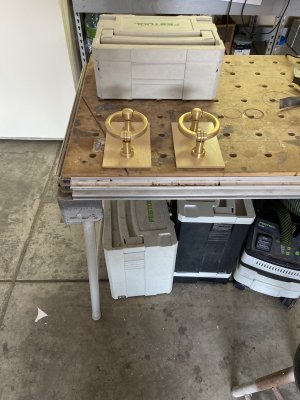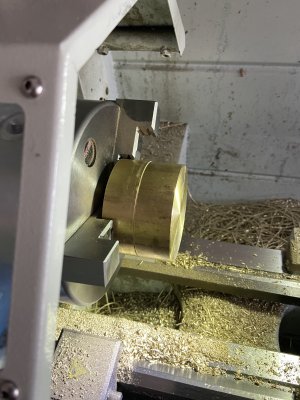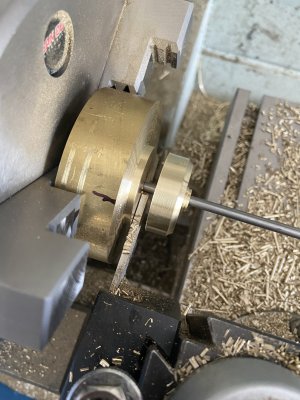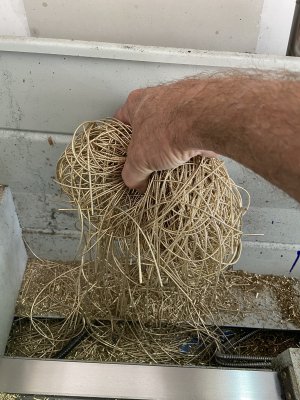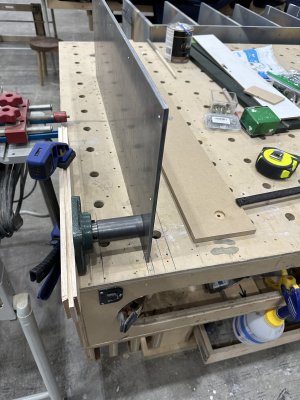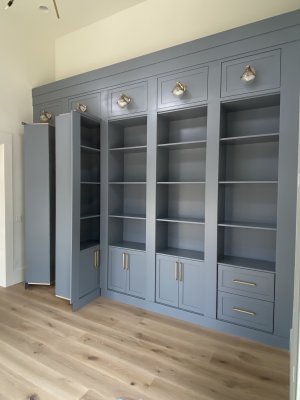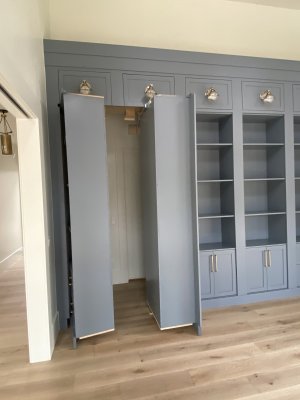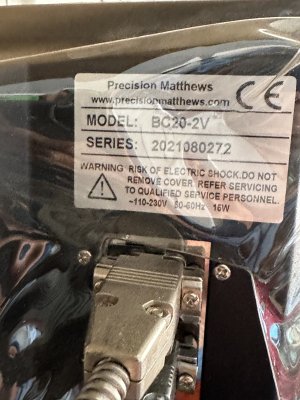You are using an out of date browser. It may not display this or other websites correctly.
You should upgrade or use an alternative browser.
You should upgrade or use an alternative browser.
Pivot bookcase
- Thread starter tjbnwi
- Start date
Cheese
Member
Hey Tom have you thought about producing that hardware on a commercial basis? Most of the present commercially available stuff really sucks.
luvmytoolz
Member
Sensational work!
If that's going to fully loaded with books that'll be some tremendous weight!
If that's going to fully loaded with books that'll be some tremendous weight!
tjbnwi
Member
- Joined
- May 12, 2008
- Messages
- 7,299
This unit replaced a “commercial” unit that didn’t last a month.Hey Tom have you thought about producing that hardware on a commercial basis? Most of the present commercially available stuff really sucks.
I have not considered marketing the hardware. The most difficult part of the hardware is turning the pivot shafts (unless you own a lathe and know how to use it). The bearing assembly is a readily available pillow block.
The most difficult part of the job is getting the trim right.
Tom
tjbnwi
Member
- Joined
- May 12, 2008
- Messages
- 7,299
Designed and stress tested in Fusion.Sensational work!
If that's going to fully loaded with books that'll be some tremendous weight!
Tom
Stevenski
Member
wow - a secret passage!!
you can play 1:1 Cluedo at home
Fantastic work - congratulations

you can play 1:1 Cluedo at home
Fantastic work - congratulations
Crazyraceguy
Member
- Joined
- Oct 16, 2015
- Messages
- 5,420
Is that something you have, or have access too, easily? I might be able to help you out with that, if you ever need them again. Shipping might be a bit of an issue, so multiple sets might be more cost effective.I have not considered marketing the hardware. The most difficult part of the hardware is turning the pivot shafts (unless you own a lathe and know how to use it). The bearing assembly is a readily available pillow block.
Tom
nclemmons
Member
Very nice work, Tom!
tjbnwi
Member
- Joined
- May 12, 2008
- Messages
- 7,299
I’ve got the lath and knowledge of how to use it covered. Thank you for the offer.Is that something you have, or have access too, easily? I might be able to help you out with that, if you ever need them again. Shipping might be a bit of an issue, so multiple sets might be more cost effective.
3 years ago I made all of the brass elements for the Parade home. The door knobs weighed about 15 pounds each. The door knockers are fully functional.
Tom
Attachments
luvmytoolz
Member
Very nice work!
And nice lathe! Pretty similar to mine by the look (1000 b/c?) although yours looks much cleaner than mine, how handy do you find the DRO on the lathe?
And nice lathe! Pretty similar to mine by the look (1000 b/c?) although yours looks much cleaner than mine, how handy do you find the DRO on the lathe?
tjbnwi
Member
- Joined
- May 12, 2008
- Messages
- 7,299
I’m old and my eyesight is not what it used to be. DRO’s make getting things dialed in exactly easy.Very nice work!
And nice lathe! Pretty similar to mine by the look (1000 b/c?) although yours looks much cleaner than mine, how handy do you find the DRO on the lathe?
I clean the lath after every use. It is a Precision Mathew’s 1228.
A little bit of brass swarf.
Tom
Attachments
Last edited:
hdv
Member
@tjbnwi : I really like the idea of such a pivot bookcase. I have just the spot for something like this. Can I ask you for things to take note of before embarking on this journey? I have never made something like this before. Building the bookcase itself and all the trim won't be an issue (I expect). But are there things to keep in mind in regards to the hardware? I am thinking of things like the positioning of the hinge, how robust it needs to be, do you use a special type of bearing to ease the movement of the bookcase? Some form of locking mechanism will probably be needed too. Do you just use a magnet, or is there a trick to it? How much sag do I need to take in account when designing something like this? I do realise much of this will depend on the weight of what will be put in the bookcase, but maybe you can provide some tips? I would appreciate it.
Cheese
Member
Nice size DRO on the lathe Tom...it seems larger than most, who makes it?
Dongar
Member
This is a tutorial by Gary Katz on installing a pivot door. https://www.thisiscarpentry.com/2012/05/11/hidden-pivot-bookcase-katz/
tjbnwi
Member
- Joined
- May 12, 2008
- Messages
- 7,299
I build them on a steel plate base. I’m not a fan of the hardware he used.This is a tutorial by Gary Katz on installing a pivot door. https://www.thisiscarpentry.com/2012/05/11/hidden-pivot-bookcase-katz/
The plate for this one and the spacer for the pillow block. The spacer is necessary to take up the space in the casting, this vertically supports the load. Me turning the axles allows me to adjust the height of the bottom to align with elements around the bookcase.
A dual swing system with file drawers. Its been in about 5 years without issues.
Tom
Attachments
tjbnwi
Member
- Joined
- May 12, 2008
- Messages
- 7,299
I had to look, it is Precision Mathew’s labeled, don’t know who makes it for them.Nice size DRO on the lathe Tom...it seems larger than most, who makes it?
Tom
Attachments
tjbnwi
Member
- Joined
- May 12, 2008
- Messages
- 7,299
I’ll get back to you later on this later.@tjbnwi : I really like the idea of such a pivot bookcase. I have just the spot for something like this. Can I ask you for things to take note of before embarking on this journey? I have never made something like this before. Building the bookcase itself and all the trim won't be an issue (I expect). But are there things to keep in mind in regards to the hardware? I am thinking of things like the positioning of the hinge, how robust it needs to be, do you use a special type of bearing to ease the movement of the bookcase? Some form of locking mechanism will probably be needed too. Do you just use a magnet, or is there a trick to it? How much sag do I need to take in account when designing something like this? I do realise much of this will depend on the weight of what will be put in the bookcase, but maybe you can provide some tips? I would appreciate it.
Tom
hdv
Member
Thanks!
smorgasbord
Member
Super impressive work!
And, maybe unfortunately, the need for this kind of thing is evaporating quickly, since everything is digital. Only first editions or other historically important artifacts really need/should be kept anymore. It's like who needs a Wooten Desk today? I've got more folders on my laptop than cubbies in the largest of those desks.
I'm surprised that LED lights haven't changed light fixtures in new homes as much as I've expected. For example, the acoustic ceilings that Spencer Lewis just installed a new modern home have cut-outs for can lights. I would have thought that running LED strips between the wood strips would have been a more elegant solution - would look better when the lights are off (no cut-outs to break the look), and would provide more even illumination when the lights are on. The only real problem with high quality LEDs (assuming CRI of 95+, etc.), is longetivity and what to do when they go out. Bulbs are easily replaced even by homeowners, but strips and other things are more challenging.
And, maybe unfortunately, the need for this kind of thing is evaporating quickly, since everything is digital. Only first editions or other historically important artifacts really need/should be kept anymore. It's like who needs a Wooten Desk today? I've got more folders on my laptop than cubbies in the largest of those desks.
I'm surprised that LED lights haven't changed light fixtures in new homes as much as I've expected. For example, the acoustic ceilings that Spencer Lewis just installed a new modern home have cut-outs for can lights. I would have thought that running LED strips between the wood strips would have been a more elegant solution - would look better when the lights are off (no cut-outs to break the look), and would provide more even illumination when the lights are on. The only real problem with high quality LEDs (assuming CRI of 95+, etc.), is longetivity and what to do when they go out. Bulbs are easily replaced even by homeowners, but strips and other things are more challenging.
Crazyraceguy
Member
- Joined
- Oct 16, 2015
- Messages
- 5,420
That's a lot of brass 
That's some great work there Tom.
That's some great work there Tom.
Similar threads
- Replies
- 5
- Views
- 859
- Replies
- 1
- Views
- 500

